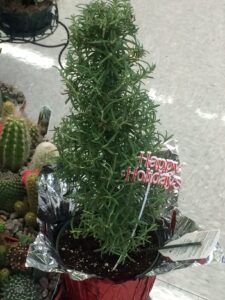
Growing Rosemary Indoor
Rosemary (Salvia rosmarinus) is a popular aromatic herb that symbolizes remembrance, friendship, and loyalty. Often sold during the holiday season in a decorated topiary form, the value of rosemary goes beyond its ornamental use. Since the Roman era, both fresh and dried rosemary has been used for cosmetics, medicinal, and culinary purposes. Rosemary oil has both antiseptic and astringent properties and is also used in making scented soaps and lotions. Fresh rosemary leaves add flavor to your food, and its unique pine scent brings holiday spirit to your home.
Rosemary is not hardy to Wisconsin and is generally grown as a potted plant (a clay pot works best for rosemary) during the growing season. It requires a well-drained, moist soil media like potting mix with some additional perlite for better drainage. In summer, select a sunny spot and bury the potted plant in the ground to its rim level. Water the plant as needed to keep the soil moist and use water soluble fertilizer once in three weeks. By mid to late fall (before first frost), dig the potted plant out and move it indoors for overwintering.
However, maintaining a rosemary plant indoors can be little tricky, as the warm and dry air inside our winter home can wither its leaves and desiccate the twigs. Rosemary needs cool and moist conditions during the wintertime. Plus it needs a good amount of sunlight or supplemental artificial light that doesn’t emit heat. And, the plant can get iffy if it is over or under-watered.
If you happen to receive a rosemary plant as a gift during the holiday season, remove the foil wrap around the container to prevent water logging and set the container in a drip tray. Station the plant near a cool, bright spot where the temperature doesn’t exceed 65° F. A south/west facing window may work, but be sure your heat register or radiator is not close to the plant. Once a week, rotate the plant so it can get an equal share of sunlight on all its sides. Alternatively, you can also station the plant inside the garage as long as the temperature doesn’t drop below freezing and allows decent amount of sunlight.
Heated homes in winter can dry out the soil moisture quickly. So check the soil moisture of the container once or twice a week by sticking your finger to an inch deep. Water the plant thoroughly if the soil seems to be dry. Once a week, mist the plant using a spray bottle or use a humidifier to boost humidity inside the house. Don’t fertilize your rosemary during the winter season. In spring, after the threat of frost, move the potted plant outside and repot it with some fresh media.




